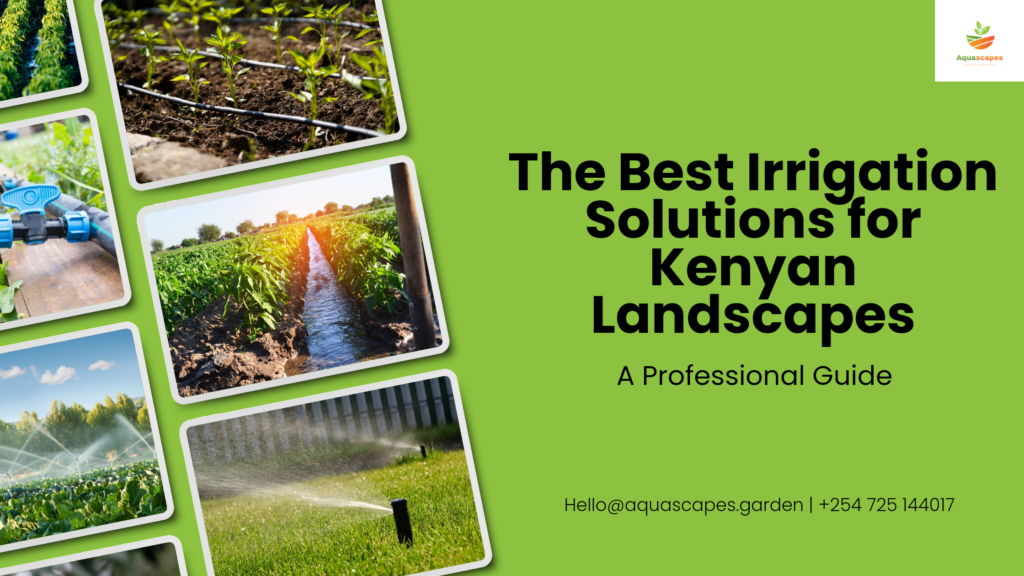The Best Irrigation Solutions for Kenyan Landscapes: A Professional Guide

In Kenya, where climate variability can challenge plant health, choosing effective irrigation systems is key to vibrant and resilient landscapes. Whether for small gardens, farms, or commercial green spaces, the right irrigation system can maximize water efficiency, ensure plants thrive, and reduce maintenance costs. This guide provides an overview of the best irrigation solutions for Kenyan landscapes.
Understanding Kenya’s Climate and Landscape Needs
Kenya’s climate varies greatly, from humid coastal areas to arid and semi-arid regions. Due to these variations, irrigation needs differ. Efficient irrigation not only conserves water but also helps counter inconsistent rainfall patterns, making it essential for both residential and commercial landscapes.
1. Drip Irrigation Systems: Efficient and Cost-Effective
Advantages:
Drip irrigation is highly efficient and is perfect for regions with water scarcity. This system slowly delivers water directly to the roots, reducing water wastage through evaporation or runoff.
- Ideal For: Crops, flower beds, vegetable gardens, and tree plantations.
- Benefits: Minimizes water use, enhances root growth, and limits weed growth.
- Installation Tips: Use quality pipes and install pressure-regulating emitters to manage water flow efficiently. Consider covering pipes to shield them from direct sunlight and increase longevity.
2. Sprinkler Irrigation: Versatile for Larger Areas
Advantages:
Sprinkler systems are suitable for larger areas and evenly distribute water over the surface, mimicking rainfall. This system works well for lawns, sports fields, and ornamental gardens where uniform coverage is required.
- Ideal For: Lawns, parks, and larger commercial landscapes.
- Benefits: Efficient for larger spaces, saves labor, and covers irregular terrain.
- Installation Tips: Space sprinklers carefully to avoid water overlap. Install timers to automate the system and prevent overwatering.
3. Surface Irrigation: Simple and Affordable
Advantages:
Surface irrigation involves channeling water across the soil surface to cover plant roots. This traditional method is economical and requires minimal equipment, making it popular among small-scale farmers.
- Ideal For: Farms, small gardens, and orchards.
- Benefits: Low-cost and easy to implement with basic tools.
- Installation Tips: Level the soil to encourage even water distribution. Use channels to guide the water flow and reduce wastage.
4. Subsurface Drip Irrigation: Water-Saving for Crops
Advantages:
Subsurface drip irrigation works similarly to drip systems but delivers water below the soil’s surface. This method is particularly effective for water conservation and targets plant roots directly.
- Ideal For: Fruit trees, vineyards, and row crops.
- Benefits: Reduces evaporation, enhances crop yield, and lowers maintenance.
- Installation Tips: Ensure proper soil drainage to avoid waterlogging. Adjust emitters according to plant growth stages for optimal hydration.
5. Rainwater Harvesting Systems: Sustainable and Cost-Effective
Advantages:
Rainwater harvesting involves collecting and storing rainwater for irrigation purposes. It’s a sustainable choice for areas with seasonal rainfall, offering a free and eco-friendly water source.
- Ideal For: All types of landscapes, particularly in areas with seasonal rainfall.
- Benefits: Reduces dependency on municipal water, promotes sustainability, and is cost-effective.
- Installation Tips: Set up gutters and storage tanks to collect rainwater. Use filters to keep the water clean for irrigation.
6. Automatic Irrigation Systems: Hands-Free Convenience
Advantages:
Automatic irrigation systems come with timers, moisture sensors, and weather-based controls to deliver water only when needed. This option is ideal for busy property owners and those with large landscapes.
- Ideal For: Commercial landscapes, urban gardens, and residential areas.
- Benefits: Saves time, conserves water, and reduces overwatering risks.
- Installation Tips: Install moisture sensors and timers to avoid overwatering. Program schedules based on seasonal needs and soil type.
Selecting the Right Irrigation System for Your Landscape
When choosing an irrigation system, consider factors such as soil type, crop or plant type, water availability, and maintenance needs. Investing in a reliable, water-efficient system can help maintain healthy, vibrant landscapes and reduce water expenses in the long run.
Final Thoughts: Making the Best Irrigation Choice for Kenya’s Landscapes
Choosing the right irrigation solution in Kenya requires understanding climate and landscape specifics. Drip and sprinkler systems are excellent for efficient water use, while traditional methods like surface irrigation remain economical for small farms. For a sustainable approach, consider rainwater harvesting. By investing in the right system, Kenyan landscapes can thrive, even in dry seasons, ensuring lasting beauty and productivity for years to come. Mail us or contact us +254 725 144017 today for an irrigation solution suitable for your garden.